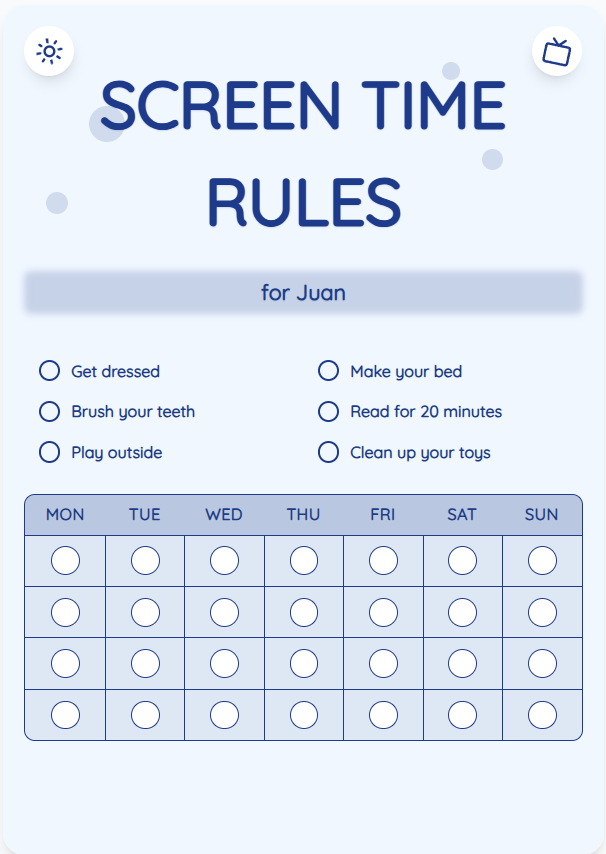Finding the Right Screen Time Balance for Your Child: A Guide for Parents
As a parent, navigating the world of screen time can be challenging. With countless digital distractions competing for your child's attention, finding the right balance is crucial for their well-being and development. In this guide, we'll explore which screen time management strategies work best for children aged 2-12, providing you with practical tips to promote a harmonious family environment.
See What Your Screen Time Chart Will Look Like
Here's an example of a beautiful, customizable screen time rules chart you can create for your family

Understanding the Impact of Screen Time on Child Development
Before diving into specific strategies, it's important to understand how excessive screen time can affect your child's development. Research suggests that prolonged screen exposure can lead to issues such as decreased social skills, disrupted sleep patterns, and reduced physical activity. By setting limits and monitoring screen time, you can help mitigate these risks and support your child's overall well-being.
Effective Screen Time Management Strategies
1. Create a screen time schedule: Establish specific time slots for screen use and ensure that they do not interfere with essential activities like homework or family meals. 2. Encourage off-screen activities: Promote hobbies, sports, and outdoor play to provide alternatives to screen time. 3. Use screen time charts: Implement visual aids like screen time charts to set clear boundaries and help children understand limits. 4. Model healthy screen habits: Be a positive role model by demonstrating responsible screen use and engaging in device-free activities with your child.
Put These Tips Into Action
Create a custom chart to implement these strategies with your child
Setting Realistic Limits and Consistency
Consistency is key when it comes to managing screen time. Set realistic limits based on your child's age and individual needs, and communicate these boundaries clearly. Be prepared to enforce consequences if rules are broken but also allow for flexibility when needed. By maintaining a balance between structure and flexibility, you can create a healthy screen time routine that works for your family.
Practical Tips for Success
- Limit screen time before bedtime to promote better sleep quality.
- Engage in screen-free activities as a family to strengthen bonds and communication.
- Involve your child in creating screen time rules to increase their ownership and understanding.
- Monitor the content your child consumes online and discuss appropriate behavior online.
Frequently Asked Questions
How can I find the right balance between screen time and other activities?
Finding the right balance requires trial and error. Start by observing how your child responds to different limits and adjust accordingly. Remember that every child is unique, so be willing to adapt your approach based on their individual needs.
Are there any recommended screen time limits for children in different age groups?
While guidelines vary, experts generally recommend limiting screen time to 1 hour per day for children aged 2-5 and 2 hours per day for children aged 6-12. However, the quality of screen time matters just as much as the quantity, so focus on promoting educational and interactive content.
By implementing effective screen time management strategies, you can create a balanced digital environment that supports your child's growth and development. Remember, moderation is key, and by prioritizing quality screen time over quantity, you can nurture healthy habits that will benefit your child in the long run. Visit ScreenTimeRules.com to explore customizable screen time charts that can help you establish clear boundaries and promote a positive screen time routine.
Ready to Transform Your Family's Screen Time?
Join thousands of parents who have successfully managed screen time with our customizable charts.
